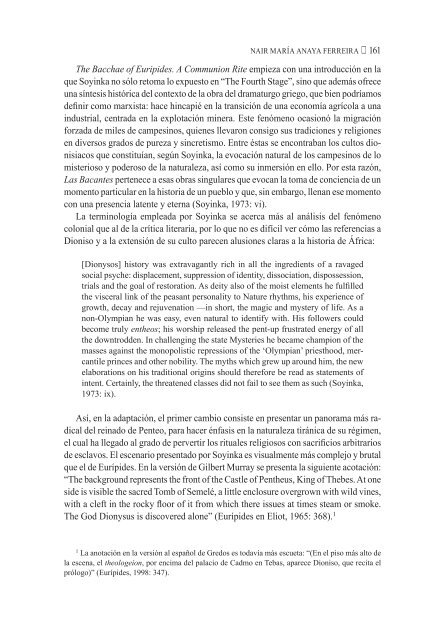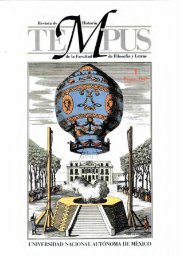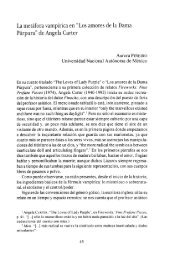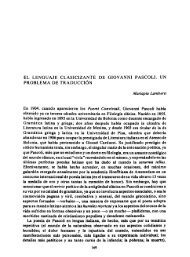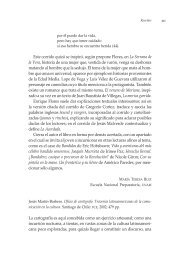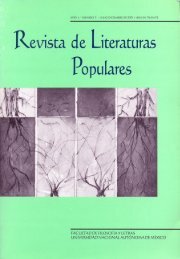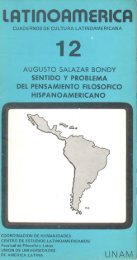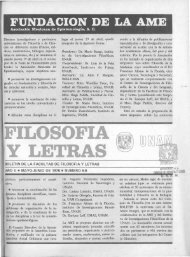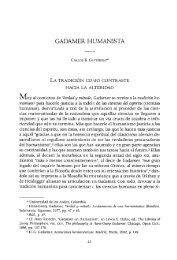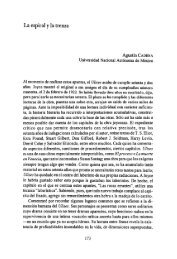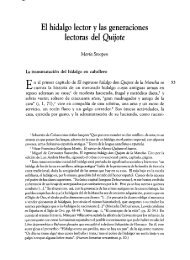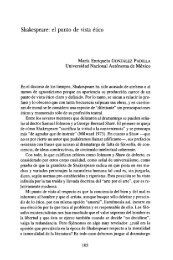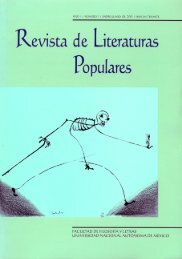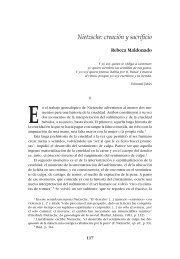Untitled - Repositorio de la Facultad de Filosofía y Letras. UNAM ...
Untitled - Repositorio de la Facultad de Filosofía y Letras. UNAM ...
Untitled - Repositorio de la Facultad de Filosofía y Letras. UNAM ...
You also want an ePaper? Increase the reach of your titles
YUMPU automatically turns print PDFs into web optimized ePapers that Google loves.
NAIr MAríA ANAYA fErrEIrA 161<br />
The Bacchae of Euripi<strong>de</strong>s. A Communion Rite empieza con una introducción en <strong>la</strong><br />
que Soyinka no sólo retoma lo expuesto en “The fourth Stage”, sino que a<strong>de</strong>más ofrece<br />
una síntesis histórica <strong>de</strong>l contexto <strong>de</strong> <strong>la</strong> obra <strong>de</strong>l dramaturgo griego, que bien podríamos<br />
<strong>de</strong>finir como marxista: hace hincapié en <strong>la</strong> transición <strong>de</strong> una economía agríco<strong>la</strong> a una<br />
industrial, centrada en <strong>la</strong> explotación minera. Este fenómeno ocasionó <strong>la</strong> migración<br />
forzada <strong>de</strong> miles <strong>de</strong> campesinos, quienes llevaron consigo sus tradiciones y religiones<br />
en diversos grados <strong>de</strong> pureza y sincretismo. Entre éstas se encontraban los cultos dionisiacos<br />
que constituían, según Soyinka, <strong>la</strong> evocación natural <strong>de</strong> los campesinos <strong>de</strong> lo<br />
misterioso y po<strong>de</strong>roso <strong>de</strong> <strong>la</strong> naturaleza, así como su inmersión en ello. Por esta razón,<br />
Las Bacantes pertenece a esas obras singu<strong>la</strong>res que evocan <strong>la</strong> toma <strong>de</strong> conciencia <strong>de</strong> un<br />
momento particu<strong>la</strong>r en <strong>la</strong> historia <strong>de</strong> un pueblo y que, sin embargo, llenan ese momento<br />
con una presencia <strong>la</strong>tente y eterna (Soyinka, 1973: vi).<br />
La terminología empleada por Soyinka se acerca más al análisis <strong>de</strong>l fenómeno<br />
colonial que al <strong>de</strong> <strong>la</strong> crítica literaria, por lo que no es difícil ver cómo <strong>la</strong>s referencias a<br />
Dioniso y a <strong>la</strong> extensión <strong>de</strong> su culto parecen alusiones c<strong>la</strong>ras a <strong>la</strong> historia <strong>de</strong> áfrica:<br />
[Dionysos] history was extravagantly rich in all the ingredients of a ravaged<br />
social psyche: disp<strong>la</strong>cement, suppression of i<strong>de</strong>ntity, dissociation, dispossession,<br />
trials and the goal of restoration. As <strong>de</strong>ity also of the moist elements he fulfilled<br />
the visceral link of the peasant personality to Nature rhythms, his experience of<br />
growth, <strong>de</strong>cay and rejuvenation —in short, the magic and mystery of life. As a<br />
non-Olympian he was easy, even natural to i<strong>de</strong>ntify with. His followers could<br />
become truly entheos; his worship released the pent-up frustrated energy of all<br />
the downtrod<strong>de</strong>n. In challenging the state Mysteries he became champion of the<br />
masses against the monopolistic repressions of the ‘Olympian’ priesthood, mercantile<br />
princes and other nobility. The myths which grew up around him, the new<br />
e<strong>la</strong>borations on his traditional origins should therefore be read as statements of<br />
intent. Certainly, the threatened c<strong>la</strong>sses did not fail to see them as such (Soyinka,<br />
1973: ix).<br />
Así, en <strong>la</strong> adaptación, el primer cambio consiste en presentar un panorama más radical<br />
<strong>de</strong>l reinado <strong>de</strong> Penteo, para hacer énfasis en <strong>la</strong> naturaleza tiránica <strong>de</strong> su régimen,<br />
el cual ha llegado al grado <strong>de</strong> pervertir los rituales religiosos con sacrificios arbitrarios<br />
<strong>de</strong> esc<strong>la</strong>vos. El escenario presentado por Soyinka es visualmente más complejo y brutal<br />
que el <strong>de</strong> Eurípi<strong>de</strong>s. En <strong>la</strong> versión <strong>de</strong> Gilbert Murray se presenta <strong>la</strong> siguiente acotación:<br />
“The background represents the front of the Castle of Pentheus, king of Thebes. At one<br />
si<strong>de</strong> is visible the sacred Tomb of Semelé, a little enclosure overgrown with wild vines,<br />
with a cleft in the rocky floor of it from which there issues at times steam or smoke.<br />
The God Dionysus is discovered alone” (Eurípi<strong>de</strong>s en Eliot, 1965: 368). 1<br />
1 La anotación en <strong>la</strong> versión al español <strong>de</strong> Gredos es todavía más escueta: “(En el piso más alto <strong>de</strong><br />
<strong>la</strong> escena, el theologeíon, por encima <strong>de</strong>l pa<strong>la</strong>cio <strong>de</strong> Cadmo en Tebas, aparece Dioniso, que recita el<br />
prólogo)” (Eurípi<strong>de</strong>s, 1998: 347).


